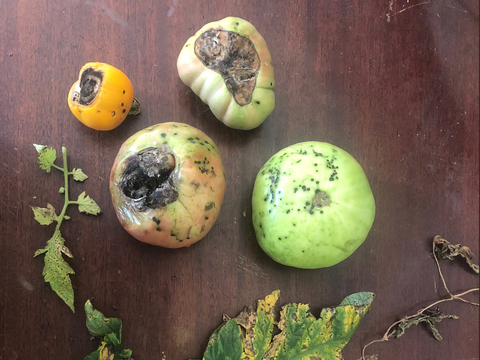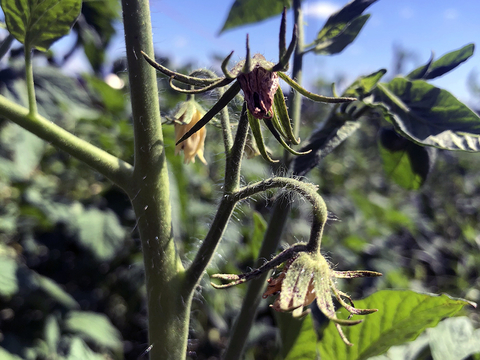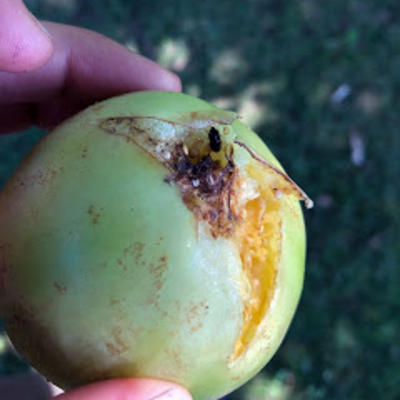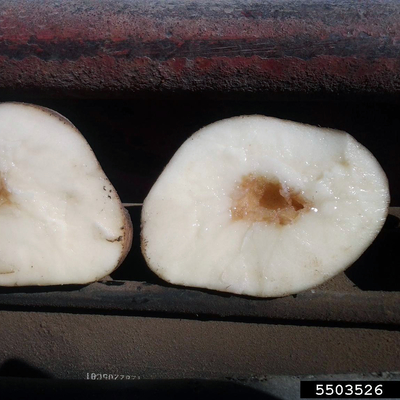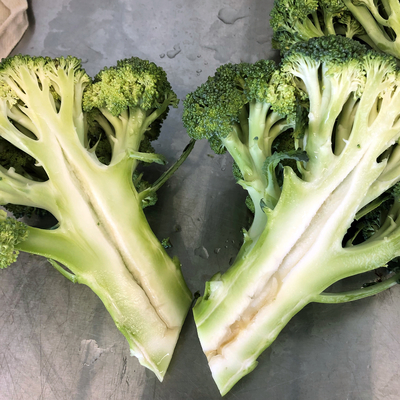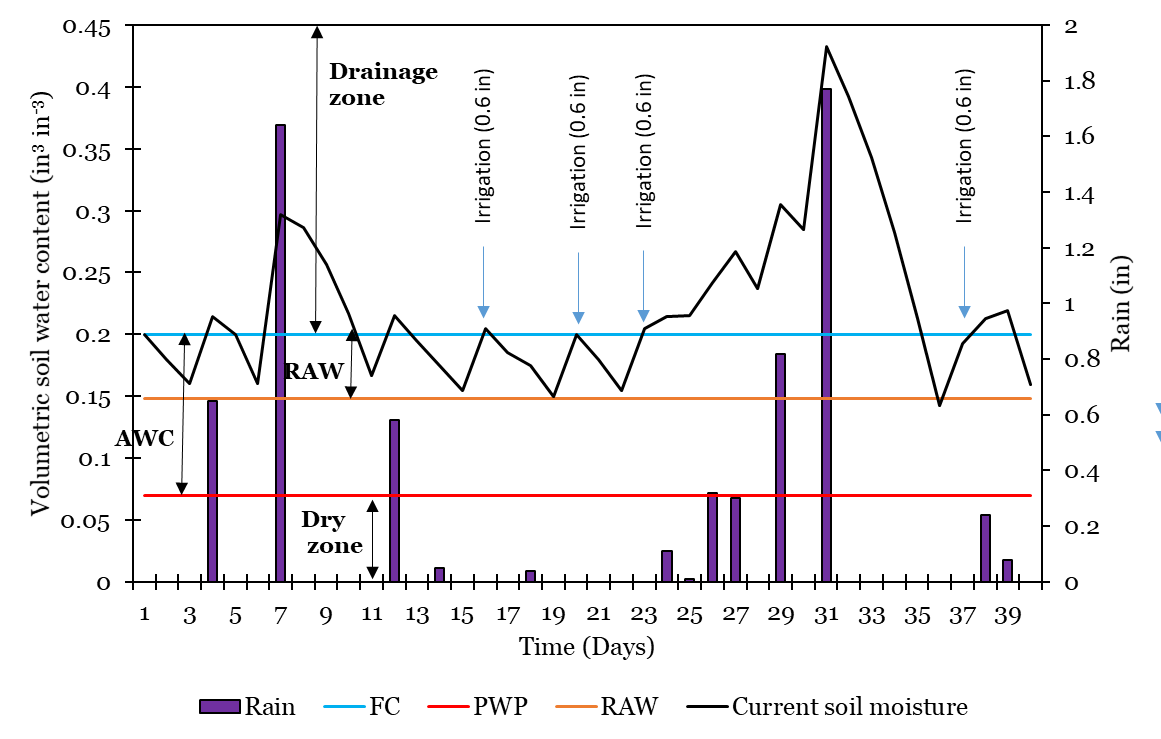Key points
- Consistent soil moisture is critical to ensuring high yields and preventing problems in fruit and vegetable crops.
- Taking the time to monitor soil moisture and develop an irrigation plan is important for farm resilience.
- Maintaining irrigation and constant moisture in the upper soil profile can help to prevent soil crusting as seeds are germinating.
- Consistent moisture during periods of heat stress can help to mitigate the impacts of heat.
The importance of consistent moisture for horticultural crops
Consistent soil moisture is critical to ensuring high yields and preventing physiological problems in fruit and vegetable crops. Many crops are severely impacted by fluctuating water levels, both in terms of yield and disorders that make crops unmarketable.
Common vegetable problems related to moisture stress
Blossom end rot in tomatoes and peppers
- Blossom end rot (BER) is a calcium deficiency but is not necessarily related to the amount of calcium in the soil.
- BER is exacerbated by soil moisture fluctuations.
- The first fruit tends to be most severely impacted.
- More information on blossom end rot.
Splitting in tomatoes
- Splitting is caused by uneven cell division rates in the inner and outer tissues of fruit and is driven by uneven moisture.
- Splitting allows for secondary pathogens and opportunistic insects to colonize fruit.
Hollow heart in potatoes
- Potatoes with hollow heart have a hollow center, often surrounded by brown tissue. The cavity is often star-shaped, or an abstract shape with straight edges rather than circular.
- Hollow heart occurs when there are abrupt changes in growing conditions
- Most commonly, hollow heart is attributed to fluctuating water levels, especially droughts followed by heavy rain.
- Water stress followed by a significant increase in moisture causes tubers to develop too quickly, causing the center tissues to pull apart.
- Hollow heart does not pose a food safety issue, it is simply a cosmetic problem. Depending on your markets, it may be a small nuisance, or it could mean discarding your crop.
Hollow stem in Brassica crops
- Hollow stem in Brassica crops is complex and caused by many interacting factors.
- Inconsistent moisture may exacerbate hollow stem, but it is rarely the only cause. Improving moisture consistency can help to reduce the severity of hollow stem, but should be combined with other management strategies.
- Other risk factors for hollow stem include fast-growing cultivars, too much nitrogen and potassium, wide plant spacing and, in some cases, boron deficiency.
- Hollow stem symptoms look very similar to the symptoms of soft rot in broccoli and collards; check with your local Extension educator or plant disease clinic if you are seeing symptoms.
Poor germination
- All seeds need consistent moisture for good germination.
- Small seeded crops like beets and carrots are especially sensitive, especially in clay soils that are prone to crusting.
- Maintaining irrigation and constant moisture in the upper soil profile can help to prevent soil crusting as seeds are germinating.
Woody, flavorless carrots
- Carrots become woody when they are water-stressed.
- Heat stress also causes woodiness; consistent irrigation can help to cool the soil.
- Carrots are susceptible to discoloration and rot with excessive moisture.
Multicentered bulbs in onions
- Yield is reduced in onions if they experience water stress at any stage.
- Onions have shallow root systems and require more frequent irrigation.
- Water stress earlier in the growing season results in more multicenter bulbs.
Blossom drop and fruit abortion
- Heat stress is the primary cause of other common problems such as blossom drop or fruit abortion in tomato, cucumber and other cucurbits.
- Consistent moisture during periods of heat stress can help to mitigate the impacts of heat.
Weather and climate trends in Minnesota
Based on trends over the past 100 years, Minnesota climatologists predict the following trends in our weather:
- Highest likelihood: More rainfall overall, and more intense rain events.
- High likelihood: Longer, more intense heat waves, more days between rain.
These predictions have important implications for vegetable growers.
- More intense rainfall events can cause flooding or waterlogging on farms and can make it difficult to get into the field on time in the spring, or harvest crops on time in the fall.
- Heatwaves can cause plant stress with impacts to crop yield and marketability.
- The combination of these factors makes maintaining consistent soil moisture a significant challenge.
- Taking the time to monitor soil moisture and develop an irrigation plan is important for farm resilience.
More information about Minnesota climate predictions.
The importance of timing
Supplemental irrigation in vegetable crops is beneficial because rainfall is erratic and rarely uniformly distributed. Even in a year when we get above average precipitation, which is very common in Minnesota, sometimes it does not happen in the critical growth period of the crop. Supplemental irrigation is required to mitigate the yield loss risk.
While consistent moisture is important throughout the lifespan of all vegetables, each crop has critical periods during which moisture is especially important.
In almost all cases, the critical period is during flowering and fruit or pod formation for flowering crops, during head formation for head forming crops, and during bulb or root enlargement for bulb and root-forming crops.
In many cases, these critical periods correspond with the hottest, driest part of the summer.
Critical growth period for irrigation requirements in vegetable crops
| Crop | Most critical period |
|---|---|
| Broccoli, cabbage, cauliflower, lettuce | head development |
| Carrot, radish, beet, turnip | root enlargement |
| Sweet corn | silking, tasseling, and ear development |
| Cucumber, eggplant, pepper, melon, tomato | flowering, fruit set, and maturation |
| Bean, pea | flowering, fruit set, and development |
| Onion | bulb development |
| Potato | tuber set and enlargement |
Table source: Midwest vegetable production guide for commercial growers
In addition to the critical periods, it has been observed that moisture deficiencies occurring early in the crop cycle may delay maturity and reduce yields. Shortages later in the season often lower quality as well as yields.
In addition to under-watering, too much water in vegetable crops, especially late in the season, can also reduce the quality and postharvest life of the crop. Applying excessive water wastes water and increases the risk of nutrient leaching.
In-season irrigation management strategies
Deciding when to irrigate to optimize production is a daily judgment call that requires you to consider several factors. Many of these factors change as the crop develops.
Below are some general guidelines to consider when developing a water management plan and setting allowable soil water deficit limits.
Before we dig more into different methods of irrigation scheduling, it is very important to understand the basics of irrigation and soil water attributes. Here are some common terms:
Saturation – The water which readily percolates or drains out from the root zone by gravitational force. Also called gravitational water.
Field capacity – It is the amount of water that remains in the soil after all the excess water at saturation has been drained out. When the soil is allowed to drain for approximately 24 hours after saturation, field capacity is reached.
Permanent wilting point – When plants uptake all the available water for a given soil, soil dries to a point that it cannot supply any water to keep plants from dying.
Available water holding capacity (AWC) –The amount of water that soil can store to be extracted by the plant. It is the water held between field capacity and permanent wilting point.
Management allowable depletion (MAD) –The soil water content where crops begin to experience water stress. Usually, most of the crop does not experience water stress before 40-60% of AWC has been removed.
Soil water deficit –The amount of water removed by the crop from active rooting depth.
Early season strategies
In the spring, always make sure the soil in the germination and early-growth root zone is moist. If necessary, irrigate to wet this zone.
- As the seedlings germinate and develop, moist soil is necessary for proper root development, as roots will not grow through a dry layer of soil. A dry layer will result in a shallower rooting depth than desirable.
- Hold back on irrigating during the early vegetative growth stages to promote deeper root growth. This increases the opportunity to store rainfall when it occurs and decreases the risk of leaching valuable nutrients.
- For most crops, the soil water deficit can be as high as 60-65% of the plant-available water (water between field capacity and permanent wilting point) in the early growth stages without affecting the plant development.
Mid-season strategies
As the crop nears its critical growth period or its peak water-use period, reduce the soil water deficit to minimize the risk of not meeting the crop's water needs and causing yield losses.
- For most crops, the soil water deficit limit in the mid-season should be 30-40% of plant-available water.
- During these critical periods of high water use, regularly project the next two to three days of water needs to plan ahead and avoid stressing the crop before it’s irrigated.
- If you use drip tape on all of your fields but only have enough water pressure to irrigate some of your fields at once, project what the water deficit will be over the next few days and use this to determine when to start irrigating.
- Too much water during this period is also potentially harmful and can result in leaching. To reduce the leaching potential of a rainfall event, always consider the weather forecast when scheduling the next irrigation.
Late season strategies
As the crop nears maturity, you can generally increase the soil water deficit (60-65% for most crops) to greater limits without causing stress to the crop.
There are several methods of irrigation scheduling. While irrigating based on the feel and appearance of the soil are commonly used methods, more precise methods such as soil water monitoring or crop water demand calculations will allow you to produce healthier, more consistent crops.
| Irrigation Scheduling Method | Description |
|---|---|
| Irrigation whenever or guessing | Water is applied whenever. |
| Feel and appearance | Water is applied based on the feel and appearance of the soil.* |
| Systematic irrigation | Water is applied systematically, without considering weather and soil water conditions. (Ex: Water is applied 3 hours a day or 1 inch every 5 days.) |
| Soil water monitoring | Using soil moisture sensors or water tension measuring tools to start irrigation. |
| Crop water demand | Water is applied according to the crop evapotranspiration (ETc). |
| Water budgeting | Apply amounts based on water balance or water budget procedure and in-situ soil water content in the root zone. |
Soil water monitoring
Soil water monitoring is an excellent method for vegetable growers. It is more precise than scheduling irrigation on a calendar basis or by feel and works well for growers with multiple crops. It is also simpler and less time consuming than calculating crop water demand or water budgeting.
Soil moisture sensors are divided into two categories depending on the technology they use:
- Sensors that measure volumetric water content, or
- Sensors that measure soil tension when placed in the soil profile.
Volumetric water content is the volume of liquid water per volume of soil. It is usually expressed as a percentage. For example, 25% volumetric water content (VWC) means that in one cubic inch of soil, there will be 0.25 cubic inches of water. When this %VWC is multiplied by the desired depth (effective rooting depth measured in inches), you can determine the total amount of water present in the rooting zone.
For irrigation scheduling, the soil water content measured using soil moisture sensors (current soil water content) is compared to the soil water content at field capacity to calculate the total water depletion in the soil profile.
Soil water depletion (D) = soil water content at field capacity – current soil water content
Field capacity can be measured very easily in the field using soil moisture sensors: The VWC measurements provided by the soil moisture sensor after 12-24 hours of heavy irrigation or rain is the field capacity of the soil.
You also can get the field capacity and available water holding capacity (AWC) values from the USDA's Web Soil Survey.
For irrigation scheduling, it is also important to understand the amount of soil water depletion that causes crops to begin experiencing stress. In general, most crops begin to experience stress when soil water depletion is 30-50% of plant-available water. This is called management allowable depletion (MAD) or irrigation trigger point.
MAD can be varied depending upon crop, growth stage, and irrigation system’s pumping capacity and can be determined accurately through trials. For instance, take a note of soil moisture when you notice that your crops started experiencing stress. Irrigation should be started when the soil water depletion is equal to the management allowable depletion.
Most common soil water content or volumetric water content sensors
Electromagnetic sensors
- These sensors indirectly measure VWC based on the dielectric and electric properties of the soil medium (soil bulk permittivity or soil dielectric constant).
- The dielectric constant is a measure of the ability of the substance to store electrical energy.
- Since soil particles, water, and air, all have different dielectric constants, their ability to store or dissipate electrical energy is different.
- This is how it can be correlated to soil water content. Some examples of electromagnetic sensors are shown in the figures below.
Neutron probe
- These sensors measure volumetric water content at various depths with a radiation source.
- The operator must be licensed and receive special training to use.
- The unit is expensive and requires a lot of time to take field readings.
Examples of soil water content and volumetric water content sensors
Click on an image to enlarge
Case study
An example of irrigation scheduling using the volumetric soil water content sensors is shown in the graph.
- The soil water was monitored at a 12-inch soil depth for a period of 40 days. The field capacity (FC) and permanent wilting point (PWP) were 0.20 and 0.07 in3 in-3, respectively ( in3 in-3 is the unit of measure for volumetric water sensors).
- Estimated soil available water holding capacity (AWC =FC - PWP) is 0.13 in3 in-3, and plant available water (PAW) at the 12-inch soil depth is 1.56 inches (PAW = AWC x Depth).
- Irrigation scheduling was set up to maintain PAW at 60% of AWC (i.e., 40% MAD), using the 0.15 in3 in-3 water (Readily available water (RAW)) as the trigger point to irrigate.
- Whenever the volumetric water content from the soil water sensor in the 12-inch soil profile reaches 0.15 in3 in-3 or close to it, irrigation of 0.6-inch is required to increase the volumetric water content by 0.05 in3 in-3 to bring it back to FC (0.2 in/in).
During the 40-day period in the example, over-irrigation was avoided by irrigating only when it was required. However, heavy rainfall events increased the water content at certain times, which is unavoidable. In the above example, the irrigation water application was accomplished manually.
There are automated systems available that can irrigate based on water status.
Soil water tension indicates the amount of energy required by plant roots to extract water from soil particles. As water is removed from the soil, soil tension increases. Soil tension is expressed in centibars or bars of atmospheric pressure. When the soil is full of water, soil water tension is close to zero.
For example, in coarse-textured soils at 25-45 centibars, 50% of AWC is depleted, so in these soils, crops should be irrigated before the sensor indicates 25-45 cb.
However, soil tension measurements are soil specific and can be inaccurate, so depending on your crop and soil observations, soil tension limits should be refined.
- At the earliest indication of water stress, use your tensiometer to measure the soil tension and note the reading.
- In the future, make sure that you irrigate before it reaches that point.
- You can track your water movement by taking measurements right after an irrigation event.
- After irrigating, if your deepest sensor gives a zero reading, that means you might have irrigated more than required.
- If it shows no change from your reading prior to irrigating, you did not irrigate enough.
Laboratory-developed charts like the soil water deficit table can also be used to convert the tension readings from sensors to soil water deficit values.
The most common soil tension sensors
Tensiometer:
- These sensors are made from a porous ceramic tip sealed to the base of a water-filled plastic tube, sealed at the top with a removable airtight cap.
- A vacuum gauge connected to the tube measures the soil tension.
Electrical resistance sensors:
- These sensors indirectly estimate soil tension by measuring the electrical resistance between two wire grids embedded in a block of gypsum, plaster, or a special material that maintains its moisture content in equilibrium with adjacent soil.
- The electrical resistance within the block varies with soil water content.
- A manufacturer's calibration curve converts the reading to soil tension. Use the table below to estimate the soil water deficit for the specific soil.
Examples of common soil tension sensors
Click an image to enlarge
Soil water deficit in inches per foot of soil for various tensions
| Soil tension in centibars | 10 | 30 | 50 | 70 | 100 | 200 | 1500* |
|---|---|---|---|---|---|---|---|
| Coarse sands | 0 | 0.1 | 0.2 | 0.3 | 0.4 | 0.6 | 0.7 |
| Fine sands | 0 | 0.3 | 0.4 | 0.6 | 0.7 | 0.9 | 1 |
| Loamy sands | 0 | 0.4 | 0.5 | 0.8 | 0.9 | 1.1 | 1.4 |
| Sandy loams | 0 | 0.5 | 0.7 | 0.9 | 1 | 1.3 | 1.7 |
| Coarse sands | 0 | 0.1 | 0.2 | 0.3 | 0.4 | 0.6 | 0.7 |
| Loams | 0 | 0.2 | 0.5 | 0.8 | 1 | 1.6 | 2.2 |
*Soil deficit at 1500 cbs is equal to total available soil water capacity.
See Irrigation management strategies.
Sensor installation and placement
Sensors should be placed at several different depths and locations in the field. Typically, sensors are placed in pairs at one-third and two-thirds the depth of the crop root zone and at two or more locations in the field, preferably in the representative soil type away from high points, depressions and slopes.
If you have multiple crops, consider monitoring and managing each of your primary crops separately. For growers who have many crops (5+ crop families), options could include: monitoring each crop family, monitoring your most valuable crops, or monitoring groups of crops with similar rooting depths or water requirements.
Some fields contain both heavy and light-textured soils. In those fields, it is recommended that each soil type be monitored and managed separately for irrigation. Field mapping technologies can be used to identify different soil, such as electromagnetic conductivity (EM) mapping. By identifying different soils (different water holding capacities), management zones can be created that can be managed separately.
High tunnels should be monitored separately from fields since evapotranspiration dynamics differ substantially between covered and uncovered environments.
Where to place sensors
- Place stationary sensors between plants within a crop row at their desired depths.
- Flag the sensors so field equipment operators can see where they are and prevent damage to them.
- Make sure that the sensor is in direct contact with soil and there is minimal soil disturbance during installation.
How to install sensors
The method of installation is dependent upon the design of the sensor. Follow the installation instructions given by the manufacturer. In general, soil moisture sensor installation is done in one of two ways:
- By digging a hole or a trench and installing sensors horizontally at different depths or
- By using an auger or soil sampling probe to bore a hole and install sensors vertically.
Care must be taken when drilling the hole. Do not install the sensor in an oversize hole as it may cause voids and air gaps. To prevent air gaps, some users use a mixture of soil and water (soil slurry) during the installation; however, in many cases, the structure of the slurry does not match the surrounding soil, which may adversely affect the sensor reading.
Other recommendations
- Use data loggers to store and log the data. This will help in data interpretation and quick decision making.
- Read the sensors every two to three days.
- Flag the location of the sensor for easy accessibility.
- Always irrigate to replenish the soil water to less than field capacity so that there is some room for potential rainfall.
- Consider your pumping capacity and application efficiency for scheduling irrigation.
Volumetric water content sensors
| Advantages | Disadvantages | Cost | |
|---|---|---|---|
| Capacitance sensors: Spectrum SMEC300, SM100; Sentek Enviroscan, Diviner 2000; METER 5TE, 5TN |
|
|
|
| Time Domain Reflectometry (TDR): Acclima true TDR 315, 315L, 310 S; Spectrum Field Scout TDR; CS 655, 650 |
|
|
|
| Neutron probe: CPN-InstroTek; Troxler |
|
|
|
Soil water tension sensors
| Advantages | Disadvantages | Cost | |
|---|---|---|---|
| Tensiometers : rrometer tensiometers |
|
|
|
| Granular matrix sensors: Irrometer watermark sensors |
|
|
|
Crop water demand
- The crop water demand method, also known as the crop evapotranspiration (ETc) method, consists of applying the daily ETc corresponding to the crop growth stage.
- This method uses the average daily ETc of previous years to determine the average volume of water required for each day.
- The calendar-based schedule also can be developed based on the ETc of the previous day, where the irrigation manager calculates the ETc from the previous day to determine the crop water requirements of the actual day.
Water budgeting method
- This method is the combination of ETc and the soil water monitoring method and is the most accurate of all methods.
- Irrigation events using this method are adjusted based on the ETc for each stage of crop development (crop water demand method).
- It is corrected using the dynamic water balance required by the soil water status method.
- The checkbook spreadsheet is one tool that can be used for water budgeting.
See more information about the ETc and water budget method.
Irmak, S., J. O. Payero, B. VanDeWalle, J. Rees, G. Zoubek, D. L. Martin, W. L. Keanz, D. E. Eisenhauer and D. Leininger. 2016. Principles and operation characteristics of watermark granular matrix sensor to measure soil water status and its practical application for irrigation management in various soil textures. Nebraska Extension Circular, EC783.
Brassicas, Hollow Stem. UMass Center for Agriculture, Food and the Environment. Adapted by G. Higgins, September 2016, from the Compendium of Brassica Diseases, eds. S.R. Rimmer, V.I. Shattuck, and L. Buchwaldt.
Shock, Clinton C., Erik B.G. Feibert, and Lamont D. Saunders. Short-duration Water Stress Decreases Onion Single Centers without Causing Translucent Scale. HortScience Volume 42: Issue 6. Oct. 2007.
Reviewed in 2020


